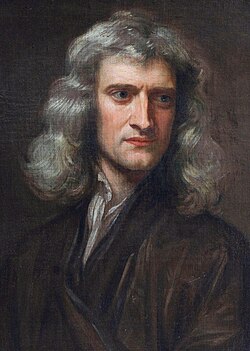އިސާކް ނިއުޓަން
Appearance
 ސަރ އިސާކް ނިއުޓަން 46 އަހަރުގައި ގޮޑްފްރޭ ނެލާ ގެ 1689 ޕޯޓްރެއިޓް | |
| އުފަން ތާރީހް | 4 ޖެނެވަރީ 1642 [OS: 25 ޑިސެމްބަރ 1642][1] ވޫލްސްތޯޕް-ބައި-ކޮލްސްޓަވޯތް، ލިންކޮންޝަޔަރ، އިނގިރޭސި ވިލާތް |
|---|---|
| އަވަހާރަވީ | 31 މާރޗް 1727 [OS: 20 މާރޗް 1726][1] ކެންސިންގޓަން، ލަންޑަން، އިނގިރޭސި ވިލާތް |
| ދިރިއުޅުނު ތަން | |
| ޤައުމު | |
| ދާއިރާ | ފިޒިސިސްޓް ހިސާބު އިލްމުވެރިއެއް، ނަކަތްތެރިކަން، ފަލްސަފާ، އަދި އަލްކެމިސްޓެއް |
| އިންސްޓިޓިއުޝަން | ޔުނިވާސިޓީ އޮފް ކެމްބްރިޖް, ރޯޔަލް ސޮސައިޓީ |
| އެލްމާ މޭޓަރ | Trinity College, ޔުނިވާސިޓީ އޮފް ކެމްބްރިޖް |
| މަޝްހޫރުވެފައިވަނީ | Newtonian mechanics Universal gravitation Infinitesimal calculus Classical optics |
އިތުރު ފާލަންތައް
[އުނިއިތުރު ގެންނަވާ]- ސައިންސްވޯލްޑް ބަޔޯގްރަފީ
- ދަ މައިންޑް އޮފް އިސާކް ނިއުޓަން By combining images, audio, animations and interactive segments, the application gives students a sense of Newton's multifaceted mind.
- Isaac Newton ގެ މަސައްކަތްތައް ޕްރޮޖެކްޓް ގޯޓެންބާގް ގައި
- Newton's First ODE - A study by Phaser Scientific Software on how Newton approximated the solutions of a first-order ODE using infinite series.
- Newton Research Project
- PDF of Newton's Principia: 1687, 1713, and 1726 editions
- Newton's Principia - read and search
- Portraits of Isaac Newton
- Sir Isaac Newton Scientist and Mathematician
- Isaac Newton އޯޕަން ޑައިރެކްޓަރީ ޕްރޮޖެކްޓް ގައި
- Rebuttal of Newton's astrology
- Newton's Religious Views Reconsidered
- Descartes, Space, and Body, an excerpt from De Gravitatione et Aequipondio Fluidorum, with annotations by Jonathan Bennett
- March 5–June 12, 2005 Isaac Newton's personal copy of Principia at Huntington Library
- Newton's Royal Mint Reports
- Newton's Dark Secrets NOVA TV programme.
- ފަންވަތް:MacTutor Biography
- Stanford Encyclopedia of Philosophy: Newton's views on space, time, and motion
- Newton's Castle Educational material
- The Chymistry of Isaac Newton Research on his Alchemical writings
- The Isaac Newton Institute for Mathematical Sciences
- Isaac Newton on £1 note.
- FMA Live! Cool program for teaching Newton's laws to kids
- Newton's religious position
- ދަ ޖެނެރަލް ސްކޯލިއަމް ޓު ނިއުޓަންސް ޕްރިންސިޕިއާ
- ↑ 1.0 1.1 During Newton's lifetime, two calendars were in use in Europe: the Julian or 'Old Style' in Britain and parts of Eastern Europe, and the Gregorian or 'New Style' elsewhere. At Newton's birth, Gregorian dates were ten days ahead of Julian dates: thus Newton was born on Christmas Day 1642 by the Julian calendar but on 4 January 1643 by the Gregorian. Moreover, the English new year began on 25 March (the anniversary of the Incarnation) and not on 1 January (until the general adoption of the Gregorian calendar in the UK in 1753). Unless otherwise noted, the remainder of the dates in this article follow the Julian calendar.

